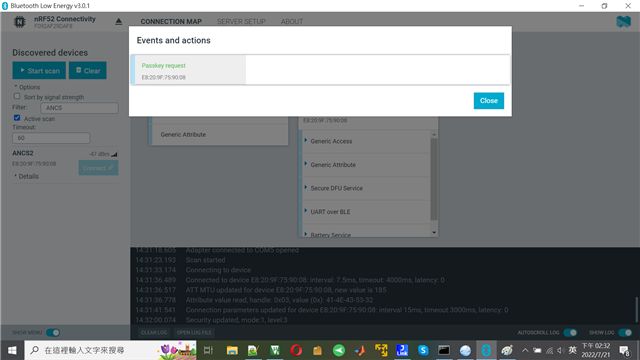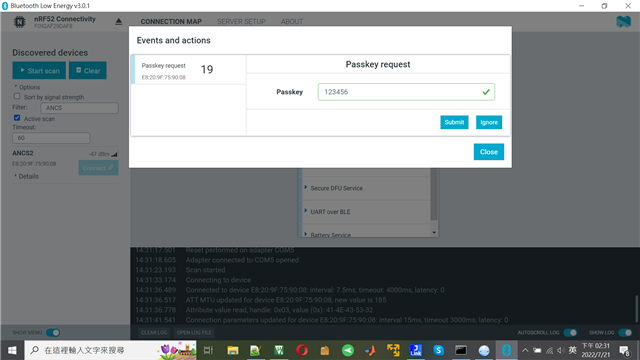I set static passkey to "123456" and enter "123456" in nRF Connect passkey request dialog. But sd_ble_gap_sec_params_reply() return 0x8 error code.
static void ble_evt_handler(ble_evt_t const* pBleEvt, void* pContext)
{
ret_code_t errCode = NRF_SUCCESS;
switch (pBleEvt->header.evt_id)
{
case BLE_GAP_EVT_CONNECTED:
{
NRF_LOG_INFO("Connected.");
BLE_UART_SetState(BLE_NUS_STATE_CONNECT);
errCode = bsp_indication_set(BSP_INDICATE_CONNECTED);
if (errCode != NRF_SUCCESS) {
NRF_LOG_WARNING("bsp_indication_set() failed, errCode=0x%x\n", errCode);
return;
}
m_cur_conn_handle = pBleEvt->evt.gap_evt.conn_handle;
errCode = nrf_ble_qwr_conn_handle_assign(&m_qwr, m_cur_conn_handle);
if (errCode != NRF_SUCCESS) {
NRF_LOG_WARNING("nrf_ble_qwr_conn_handle_assign() failed, errCode=0x%x\n", errCode);
return;
}
ble_gap_sec_params_t secParam;
secParam.bond = SEC_PARAM_BOND;
secParam.mitm = SEC_PARAM_MITM;
errCode = sd_ble_gap_authenticate(m_cur_conn_handle, &secParam);
if (errCode != NRF_SUCCESS) {
NRF_LOG_WARNING("sd_ble_gap_authenticate() failed, errCode=0x%x\n", errCode);
return;
}
}
break;
case BLE_GAP_EVT_DISCONNECTED:
if (fstorageGetState() == FSTORAGE_STATE_ERASED) {
fstorageWaitUpdateRecordFinish();
}
NRF_LOG_INFO("Disconnected.");
BLE_UART_SetState(BLE_NUS_STATE_DISCONNECT);
m_cur_conn_handle = BLE_CONN_HANDLE_INVALID;
break;
case BLE_GAP_EVT_SEC_PARAMS_REQUEST:
NRF_LOG_INFO("BLE_GAP_EVT_SEC_PARAMS_REQUEST\n");
ble_gap_sec_params_t secParam;
securityParametersGet(&secParam);
errCode = sd_ble_gap_sec_params_reply(m_cur_conn_handle,
BLE_GAP_SEC_STATUS_SUCCESS,
&secParam,
NULL);
if (errCode != NRF_SUCCESS) {
NRF_LOG_WARNING("sd_ble_gap_sec_params_reply() failed, errCode=0x%x\n", errCode);
return;
}
break;
case BLE_GAP_EVT_AUTH_STATUS:
NRF_LOG_INFO("BLE_GAP_EVT_AUTH_STATUS\n");
if (pBleEvt->evt.gap_evt.params.auth_status.auth_status != BLE_GAP_SEC_STATUS_SUCCESS) {
errCode = sd_ble_gap_disconnect(m_cur_conn_handle,
BLE_HCI_REMOTE_USER_TERMINATED_CONNECTION);
if (errCode != NRF_SUCCESS) {
NRF_LOG_WARNING("sd_ble_gap_disconnect() failed, errCode=0x%x\n", errCode);
return;
}
}
break;
default:
// No implementation needed.
break;
}
}
log messages:
0> <info> app: Version 1.0.0
0>
0> <info> app: ========| flash info |========
0> <info> app: erase unit: 4096 bytes
0> <info> app: program unit: 4 bytes
0> <info> app: end address: 0x7FFFF
0> <info> app: ==============================
0> <info> app_timer: RTC: initialized.
0> <debug> app: NOR_DATA_PERIOD=819
0>
0> <debug> app: NOR_RECORD_PERIOD=8192
0>
0> <info> app: bsp_button_longkey_handler 0.
0> <warning> app: Battery volage 495mV is too low
0>
0> <warning> app: Battery volage 93mV is too low
0>
0> <warning> app: Battery volage 8mV is too low
0>
0> <warning> app: Battery volage 0mV is too low
0>
0> <debug> app: Battery volage 4058mV
0>
0> <info> app: POWER_ON.
0> <info> app: External devices initializing start
0> <info> app: External devices initializing finish
0> <info> app: bsp_button_longkey_handler 1.
0> <debug> nrf_ble_gatt: Requesting to update ATT MTU to 185 bytes on connection 0x0.
0> <info> app: Connected.
0> <debug> app: state=1
0>
0> <debug> nrf_ble_gatt: ATT MTU updated to 185 bytes on connection 0x0 (response).
0> <info> app: BLE_GAP_EVT_SEC_PARAMS_REQUEST
0>
0> <warning> app: sd_ble_gap_sec_params_reply() failed, errCode=0x8
0>
0> <info> app: Connection secured: role: 1, conn_handle: 0x0, procedure: 2.
0> <info> app: BLE_GAP_EVT_AUTH_STATUS




